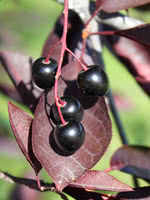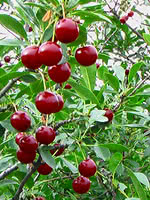Mon-Fri 9am - 5pm Mountain time
Schubert Chokecherry vs Juliet Cherry
Prunus virginiana Schubert
Prunus x kerrasis Juliet
NOT AVAILABLE THIS SEASON - MIGHT RETURN
Schubert Chokecherry is similar to a western chokecherry but features beautiful purple-red leaves throughout the summer.
This small, flowering tree is perfectly suited as an ornamental for city yards.
The fruit from this tree is a staff favourite for jams, jellies, and wines.
Juliet Cherry is a cold-hardy dwarf sour cherry. The deep burgundy fruit are known for being sweeter than other varieties, often considered one of the sweetest dwarf sour cherries. They are well suited to fresh eating, baking, and preserves. In the spring, beautiful white flowers cover the branches, adding ornamental value.
Juliet Cherry was developed at the University of Saskatchewan. It is recommended to grow dwarf sour cherries as a shrub rather than a small tree. The shrub form tends to bear fruit earlier and is less susceptible to winterkill.
Sour cherries are self-fertile; however, planting with additional varieties for cross-pollination can increase yields.
Schubert Chokecherry Quick Facts
Juliet Cherry Quick Facts
Toxicity: Toxic to animals with segmented stomachs (horses, cattle, deer moose, etc.)

